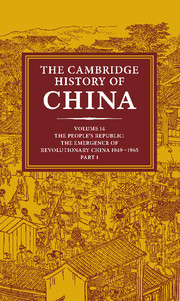Book contents
- Frontmatter
- 1 The reunification of China
- PART 1 EMULATING THE SOVIET MODEL, 1949–1957
- 2 Establishment and consolidation of the new regime
- 3 Economic recovery and the 1st Five-Year Plan
- 4 Education for the new order
- 5 The Party and the intellectuals
- 6 Foreign relations: from the Korean War to the Bandung Line
- PART II THE SEARCH FOR A CHINESE ROAD, 1958–1965
- Bibliographical Essays
- Bibliographical essays for chapters
- Bibliography
- Appendixes: Meetings and Leaders
- Conversion Tables: pinyin and Wade-Giles
- Glossary Index
- Map 1. China’s physical features
- Map 2. PRC: political (Wade–Giles romanization)
- Map 3. PRC: political (pinyin romanization)
- References
2 - Establishment and consolidation of the new regime
from PART 1 - EMULATING THE SOVIET MODEL, 1949–1957
Published online by Cambridge University Press: 28 March 2008
- Frontmatter
- 1 The reunification of China
- PART 1 EMULATING THE SOVIET MODEL, 1949–1957
- 2 Establishment and consolidation of the new regime
- 3 Economic recovery and the 1st Five-Year Plan
- 4 Education for the new order
- 5 The Party and the intellectuals
- 6 Foreign relations: from the Korean War to the Bandung Line
- PART II THE SEARCH FOR A CHINESE ROAD, 1958–1965
- Bibliographical Essays
- Bibliographical essays for chapters
- Bibliography
- Appendixes: Meetings and Leaders
- Conversion Tables: pinyin and Wade-Giles
- Glossary Index
- Map 1. China’s physical features
- Map 2. PRC: political (Wade–Giles romanization)
- Map 3. PRC: political (pinyin romanization)
- References
Summary
AN OVERVIEW
When the People's Republic of China (PRC) was formally established on October 1, 1949, the nation's new leaders faced daunting problems. Society and polity were fragmented, public order and morale had decayed, a war-torn economy suffered from severe inflation and unemployment, and China's fundamental economic and military backwardness created monumental impediments to the elite's goals of national wealth and power. Yet by 1957 the leaders of the Chinese Communist Party (CCP) could look back on the period since 1949 with considerable satisfaction. A strong centralized state had been established after decades of disunity, China's national pride and international prestige had grown significantly as a result of fighting the world's greatest power to a stalemate in Korea, the country had taken major steps on the road to industrialization and achieved an impressive rate of economic growth, the living standards of its people had made noticeable if modest progress, and the nation's social system had been transformed according to Marxist precepts in relatively smooth fashion.
Moreover, all this had been accomplished with only limited divisions within the Party elite. Thus Chairman Mao Tse-tung could convincingly claim at the Eighth CCP Congress in September 1956 that “we … have gained a decisive victory in the socialist revolution [and] our Party is now more united, more consolidated than at any time in the past.” A year later, intervening events and persistent problems set the stage for considerably enhanced elite conflict as the CCP began to evolve the bold new developmental strategy of the Great Leap Forward; yet Mao reaffirmed that the socialist revolution had been achieved, while his leading colleague, Liu Shao-ch'i, plausibly argued that Party unity remained firm.
Keywords
- Type
- Chapter
- Information
- The Cambridge History of China , pp. 49 - 143Publisher: Cambridge University PressPrint publication year: 1987
References
- 9
- Cited by



